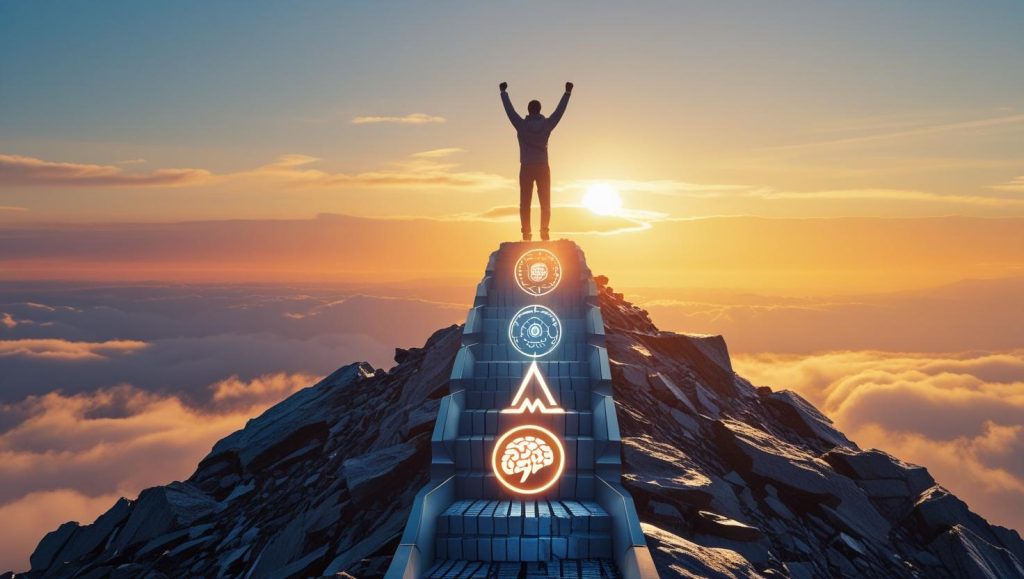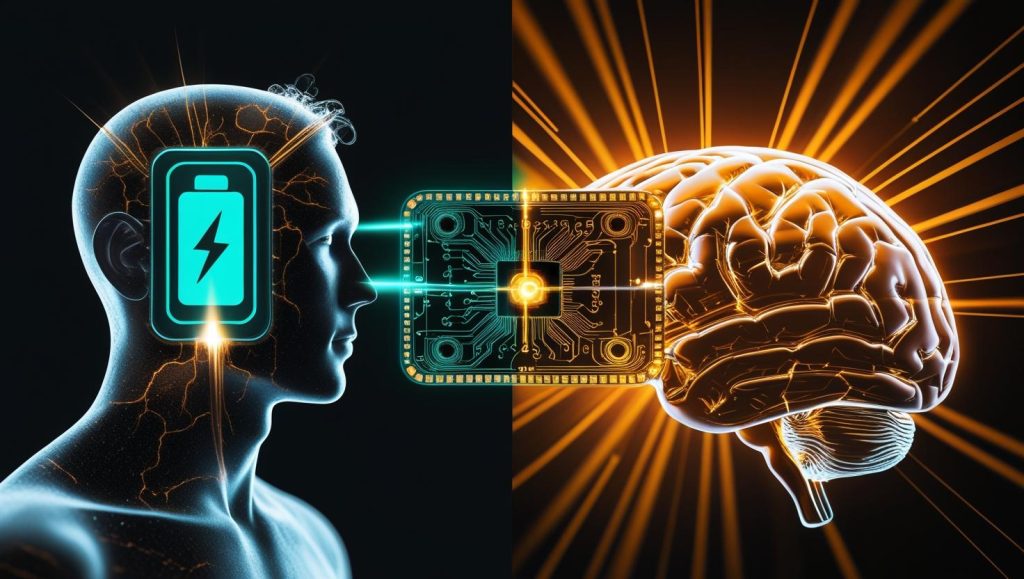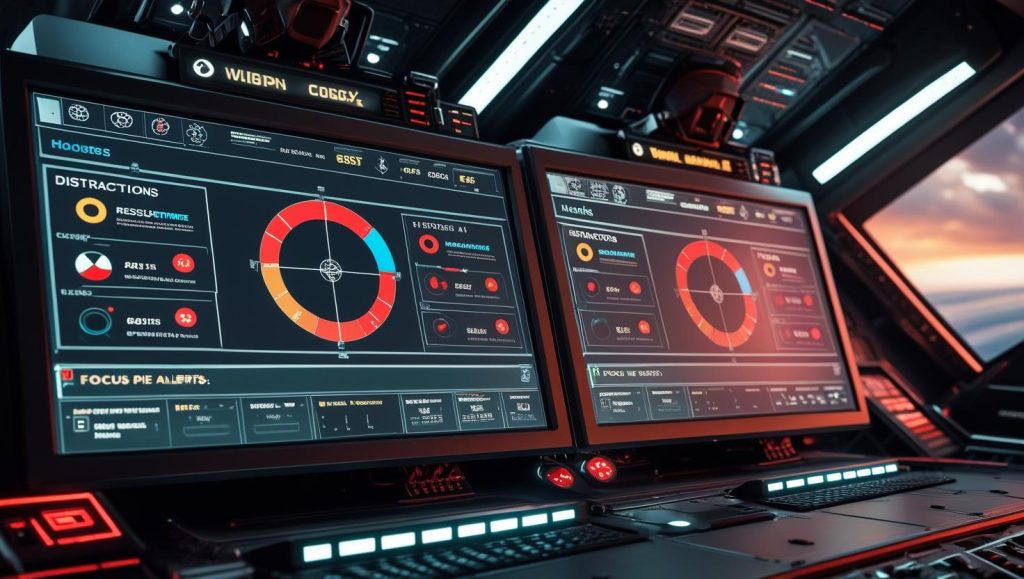This isn’t about squeezing more hours from the day. It’s about doing better work with less stress, more clarity, and sustainable energy. In this three-part series, we’ll explore how AI is transforming the way we work, learn, and live—starting with how it’s redefining peak mental performance.
What peak mental performance really means (and why it’s so rare)
To perform at your peak isn’t about constant hustle or grinding for 12 hours a day. It’s about entering what psychologist Mihaly Csikszentmihalyi called the “flow state”—a cognitive zone where time fades, distractions fall away, and your brain feels fully aligned with the task at hand. It’s a mental sweet spot where performance feels effortless, and creativity, decision-making, and memory all operate at their highest level.
So why is this state so rare for most people? Because our modern environment is engineered for interruption. According to a University of California Irvine study, the average office worker is interrupted every 11 minutes, and it can take up to 23 minutes to regain full focus. Add to that decision fatigue—stemming from the 35,000 decisions we make each day—and you get a cognitive load that drains mental resources before meaningful work even begins.
As Dr. Andrew Huberman, a neuroscientist at Stanford, puts it: “Our brains were not designed for the way we live and work today.” We’ve evolved for short bursts of attention, not long hours of uninterrupted thought. But by understanding our biology and rhythms—and integrating tools that respect and respond to them—we can begin to restore what’s been lost.
That’s where AI comes in. These systems track, learn, and adapt to your cognitive cycles. They can spot when your attention is dipping, offer tailored nudges to restore focus, or rearrange your day to match your mental peaks. Instead of forcing willpower, they provide a cognitive scaffold—helping you operate in flow more often and with less effort.
The shift to neuro-adaptive systems
We’ve all used traditional productivity tools—calendars, to-do lists, project managers—but these tools are static. They don’t care if you’re sleep-deprived, emotionally exhausted, or stuck in mental fog. Neuro-adaptive AI tools, on the other hand, dynamically respond to how you’re functioning in the moment.
Take Motion, for example. It automatically schedules your most mentally demanding tasks during your cognitive prime—often based on usage patterns and subtle behavioral data. If you’re more focused in the morning, Motion will block deep work in that window and push meetings to less optimal times. Reclaim goes even further, constantly reshuffling your calendar in real-time based on current priorities, deadlines, and even your predicted energy dips.
Then there’s Notion AI, which can rewrite notes into formats that align with how you best retain information—whether that’s bullet points, summaries, or flowcharts. It doesn’t just help you store knowledge; it helps you engage with it more effectively based on how your brain works.
This is what makes neuro-adaptive systems revolutionary. They don’t just track input. They anticipate need. As one early adopter put it, “It’s like having a second brain that knows when I’m about to get distracted—and reroutes me before it happens.”
Even more sophisticated tools like Serene and Sunsama use AI to monitor patterns of overwork, decision fatigue, and attention lapses—then proactively suggest breaks, rescheduling, or recovery rituals. They serve as intelligent buffers between your intentions and your execution, nudging you back toward flow and balance without micromanaging your every move.
Rebuilding focus in the age of distraction
Focus isn’t a mindset—it’s an environment. And today’s digital environment is designed to fragment it. Between emails, chat messages, app alerts, and news feeds, the average knowledge worker switches tasks every three to ten minutes. Each time, cognitive residue builds, making it harder to concentrate and easier to burn out.
This is where AI-driven focus tools come into play. RescueTime analyzes your screen behavior to detect when you’re drifting. It then provides weekly reports that help you identify patterns—when you’re most focused, when you’re not, and what’s stealing your time. Over time, this data becomes a mirror that shows how and where your attention erodes.
Complementing this is Brain.fm, a tool that uses AI-generated music to stimulate neural circuits associated with deep concentration. These tracks are tested with EEG devices to ensure they trigger specific brain states. Unlike regular playlists, Brain.fm adjusts to your activity and can gently guide you into flow states within 10–15 minutes.
Then there’s Flow Lab, a lesser-known but powerful app that acts like a personal coach for your attention span. It uses real-time feedback from your phone and wearable data to suggest personalized interventions—like short breathing exercises, micro-breaks, or switching to lighter tasks until cognitive recovery kicks in. It essentially recreates the type of coaching used by elite athletes—except it’s for your brain.
For a practical breakdown of how these tools work together, check out our companion guide on optimizing focus and energy with AI. The takeaway? You don’t need to fight for focus. You need a system that protects it automatically.
Habit engineering through feedback, not force
Building new habits is one of the most powerful ways to change your life—and one of the hardest. Research from the University College London shows that, on average, it takes 66 days of consistent repetition for a new habit to become automatic. The problem? Most people never make it past week three. They either forget, lose motivation, or try to change too much at once.
This is where AI steps in with a new solution: systems that don’t just remind you of your goals, but adapt to your behavior to help you reach them. Tools like Fabulous, Rize, and Memo AI use intelligent feedback loops to reduce friction and increase follow-through.
Fabulous goes beyond basic habit reminders. It uses behavioral psychology and machine learning to reinforce identity-based habits. For example, instead of simply nudging you to drink water, Fabulous reframes the action as part of who you are: “You’re someone who prioritizes wellness.” Over time, this identity-driven model builds intrinsic motivation. You’re not just ticking boxes—you’re becoming the kind of person who lives the habits you want.
Rize, on the other hand, passively observes your digital behavior—how long you focus, how often you context-switch, and where your time goes. It then delivers personalized reports and nudges to gently steer you back toward more productive patterns. If you start multitasking more than usual, Rize doesn’t judge—it just suggests a micro-adjustment, like focusing on one task for the next 20 minutes. It’s a system built on compassion and consistency.
Then there’s Memo AI, which turns information capture into cognitive reinforcement. Let’s say you read a great insight in a newsletter or during a meeting. Memo AI grabs it, categorizes it, and transforms it into a spaced-repetition flashcard—automatically. This turns passive reading into active recall. Over time, you build a second brain that helps retain and apply what you learn.
One example: Sarah, a UX designer juggling client meetings and constant research, struggled to retain what she read. After using Memo AI, she began reviewing three auto-generated flashcards each morning—based on her highlights from the previous week. Within a month, she not only remembered more but began incorporating insights into design work without rereading notes. “It’s like my mind finally got organized,” she said.
Even more impressive are the cross-platform integrations. Rize connects with AI-powered habit design models that adjust routines based on your actual progress. And Memo AI syncs with platforms like Notion and Readwise, creating a seamless flow from idea capture to memory retention. It’s not just about forming habits—it’s about forming smart habits that stick.
Biometric intelligence: syncing mind and body
Mental performance isn’t only about what’s in your head—it’s also about what’s happening in your body. Your focus, creativity, and resilience are tightly linked to your biological rhythms. Sleep cycles, heart rate variability (HRV), cortisol levels, and even your glucose response can affect how well your brain functions on any given day.
Fortunately, a new class of AI-driven biometric tools now make it easy to monitor and optimize these hidden performance factors. Tools like Eight Sleep, WHOOP, and BioLite bridge the gap between biology and productivity by turning body signals into actionable insights.
Eight Sleep is more than a mattress—it’s a personalized sleep coach. Its thermal system adjusts the temperature of your bed throughout the night to match your sleep stages. For example, if your body temperature rises during REM sleep, Eight Sleep cools your bed to help you stay in that stage longer. According to company data, users experience up to 34% more deep sleep after two weeks of use. That translates directly into improved memory, emotional control, and cognitive clarity the next day.
WHOOP is a wearable that measures strain, sleep, and recovery through detailed biometrics like HRV, resting heart rate, and respiratory rate. Each morning, WHOOP gives you a “recovery score” that tells you whether your body is ready for high output or needs to take it easy. For people doing mentally demanding work, this kind of feedback is gold. It helps you decide whether to tackle creative work now or delay it until your system is more aligned.
Take Leo, a senior engineer at a fintech startup. He was experiencing brain fog most afternoons and assumed he needed more caffeine. But WHOOP data revealed poor HRV due to overtraining at night. By adjusting his workout schedule and improving sleep hygiene, his focus returned within days—no extra coffee needed.
BioLite takes a different approach. It regulates your circadian rhythm using light-based cues. Its AI-driven desk lamp mimics sunlight during the day and shifts to warmer tones in the evening, reducing melatonin suppression. This helps reset your internal clock, improving sleep onset and morning alertness. For remote workers stuck in dim home offices, this can be a game-changer.
Even more exciting is what’s coming next. Tools like ZOE are now using gut microbiome data to optimize mental clarity via nutrition. Others, like Levels, track blood glucose in real time, helping you avoid the energy crashes caused by poor food timing. These insights aren’t just for elite biohackers anymore—they’re entering the mainstream of workplace wellness.
We explore more on this in our feature on AI sleep coaching for performance, but the message is clear: if you want better focus, start by fixing your recovery. Mental performance starts at the cellular level.
Ultimately, biometric intelligence gives you a new kind of control—not over others, but over yourself. Instead of guessing whether you’re sharp today, you can look at your data. Instead of pushing through brain fog, you can pivot toward tasks better suited to your current state. That’s not weakness—it’s strategic self-awareness.
The cognitive OS: building a unified mental system
Most productivity tools today operate in silos—your calendar doesn’t talk to your habit tracker, your sleep app doesn’t influence your focus planner, and your task manager has no clue how you’re feeling. But what if all these tools could work together? What if they could form a single, adaptive system for managing your mental energy, cognitive load, and personal growth?
This is the vision of a cognitive operating system—a unified stack of AI-powered tools that track, align, and optimize your entire performance landscape. At the core, you have scheduling systems like Motion, which dynamically plans your day based on cognitive peaks. Combine this with Brain.fm to set your focus environment, RescueTime to monitor distraction, and Rize to adjust behavior over time.
Add Fabulous for routine reinforcement, Memo AI for memory enhancement, Eight Sleep and WHOOP for biological sync—and you have a full-stack system that supports your mind like an operating system supports your computer.
Advanced tools are now going even further. Levels and ZOE analyze glucose and gut-brain data to predict energy and mood changes. Some dashboards correlate poor REM sleep with lower task completion or increased distraction the next day. The future isn’t just about logging data—it’s about interpreting it, linking it, and acting on it in real time.
In short, your AI-powered cognitive OS becomes a strategic partner. It helps you decide when to push and when to rest. It reminds you when your routines slip, and adapts based on real conditions—not assumptions. This is not about micromanaging your day. It’s about removing friction, increasing adaptability, and giving your brain the support it needs to thrive.
Avoiding the optimization trap
With all these powerful tools, there’s one risk we can’t ignore: the pressure to optimize everything. It’s tempting to fall into the trap of constant performance improvement—always tracking, always tweaking, always trying to be “better.” But this mindset, ironically, can backfire. It can erode joy, increase anxiety, and disconnect you from why you started in the first place.
Psychologists call this “optimization fatigue”—the burnout that comes not from overwork, but from trying too hard to engineer a perfect life. As digital minimalism author Cal Newport warns, “Efficiency without direction is dangerous.” If you’re constantly chasing better metrics without reflecting on what matters, you end up building a productivity system that serves itself, not you.
This is why the best AI tools are now being designed with intentional friction—moments where the system pauses and asks: “How did that task feel?” or “Was this routine meaningful?” These reflective prompts, now available in tools like Notion AI, shift the emphasis from output to fulfillment. It’s not just about getting more done—it’s about doing what matters, more mindfully.
Behavioral designers like Nir Eyal recommend building “stopping points” into any optimized system. Just because something can be tracked doesn’t mean it should be. And just because a tool nudges you doesn’t mean you have to comply. Your agency is part of your mental health. AI should assist, not dictate. It should help you become more of yourself—not a caricature of peak efficiency.
So ask yourself: Is your tech serving your life—or running it? Are your systems freeing your attention—or chaining it to a dashboard? This is the real test of a smart productivity ecosystem: does it make you feel more human?
A real-world stack: from burnout to balance
To see all this in action, let’s meet Jordan—a mid-level product manager at a fast-scaling SaaS company. Six months ago, Jordan was working 60-hour weeks, juggling product roadmaps and sprint meetings while battling frequent energy crashes and brain fog. He was tracking everything manually, from tasks to meals to sleep, but nothing seemed to help.
Then Jordan discovered AI performance tools. He started with Motion, which automatically blocked 9:30–11:30 AM for deep work—based on his highest-focus window from RescueTime data. He added Brain.fm during those blocks to enter flow faster. Fabulous helped him stick to a bedtime routine, which boosted sleep quality tracked by Eight Sleep. Memo AI turned weekly strategy sessions into smart flashcards for easy retention. And WHOOP gave daily recovery scores, helping him know when to push and when to pause.
Within a month, Jordan saw a 25% increase in deep work hours, a 40% drop in afternoon distractions, and significantly improved energy levels throughout the week. “For the first time,” he said, “my systems are working for me—not the other way around.”
His success wasn’t just the tools. It was how they worked together, responding to his needs in real time. He wasn’t optimized—he was aligned. And that’s the real power of an AI-driven performance stack: sustainable, personalized productivity that improves not just what you do—but how you feel doing it.
Final thoughts
Peak mental performance isn’t a secret reserved for elite athletes or Silicon Valley execs anymore. It’s a programmable system, made possible by AI tools that understand how you think, work, and recover best. These tools don’t replace grit or discipline—but they remove the friction that drains it.
We’re entering a new era of productivity—one where technology doesn’t just make us faster, but helps us become more intentional, resilient, and creatively fulfilled. With the right stack, you can build a system that protects your focus, enhances your energy, and aligns your output with what really matters.
Ultimately, AI is not here to optimize you into a machine. It’s here to help you become fully human in your work. To work in rhythm with your biology. To operate in flow. And to live and create at your true cognitive potential—every single day.



